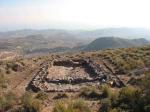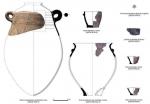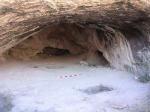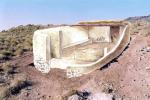Summary (English)
The archaeological action was aimed at documenting two sites located east of the Bussot municipality and within the construction area of the “El Cabeçonet” quarry: Alto Salmitre I and Alto Salmitre IV. The sites were discovered during an archaeological field survey conducted in the L’Alacantí region between 2002 and 2004.
The archaeological materials recovered in Alto Salmitre I correspond to the Orientalizing-Ancient Iberian period, whereas those from Alto Salmitre IV appear to date back to prehistoric times.
Alto Salmitre I is an open-air site near the summit of “El Cabeçonet”. Its elevation causes it to be an unprotected site, exposing it to strong winds, low temperatures in the winter, and high temperatures in the summer, in spite of the proximity of the sea. It is surrounded by steep slopes, especially to the northwest and northeast, where the drop is quite pronounced. We do not know how the land in the southeast used to be, given that a quarry has cut out that side of the mountain. From this point there are notable views of the surrounding area.
Alto Salmitre IV is a shelter located to the northeast of the El Cabeçonet mountain range. Due to its location and characteristics, it is more protected from the wind and the inclement weather. A north-northeastern orientation allows the observation of certain elevated areas of the La Marina Baixa region, but the last mountainous foothills considerably reduce visibility.
A complete superficial excavation was considered for Alto Salmitre I because of the abundance and density of rocks found there, possibly originating from the collapse of the previously standing structure. The Inventory of the Directorate General of Cultural Heritage, particularly the fragments of imported amphora, dates this site back to the Orientalizing period, during the 6th century BC..
The rocky shelter of Alto Salmitre IV was assigned a Bronze Age timeline (2nd millennium BC) by the Inventory as a result of finding a handmade ceramic fragment. Consequently, two archaeological surveys were planned before the complete excavation.
As a preliminary step, a survey of the nearby “El Cabeçonet” mountain rage was conducted before the excavation of Alto Salmitre I in order to confirm the existence of other remains in the vicinity. We then located fragments of handmade receptacles as well as Orientalizing vessels made with a potter’s wheel. The base of an oval cabin constructed and built during the Orientalizing period was found in a riverbed located northwest of the mountain range. The inner side was formed by a line of vertically set slabs, and the outer side by masonry, with a width that oscillated between 0.52 and 0.85 meters. The cabin boasts three rooms: one with an ample-sized bench that was connected to the wall (Room I), another central room (Room II) with a smaller bench, and a third (Room III), which corresponds to the entranceway.
The recovered ceramics, which are quite fragmentary, was covered by the collapsed structure indicating that it would be situated above the benches. The aforementioned wares appear to have been made locally, and by hand, using reddish and black clays and an oxidation and/or reduction firing.
Fragments from Orientalizing receptacles made of yellow and orange-colored clay were also found. Among them was a Rachgoun-1 style amphora dated from the transition between the Late Bronze Age and the Orientalizing period, in the 7th century BC. An iron pan and a perforated seashell were also found in the occupation level of Room I.
(translation by Emily Marie Polacek)
- Fernando E. Tendero Fernández y Rafael Ortiz Temprado
Director
- Rafael Ortiz Temprado y José Luis Ferrer Castelló (T.P.C., S.L.)
Team
- Anna García Barrachina, José David Busquier Corbí, Gabriel Segura Herrero y Fernando E. Tendero Fernández
- MARQ, Museo Arqueológico Provincial de Alicante
Research Body
- Colegio Oficial de Doctores y Licenciados en Filosofía y Letras y en Ciencias de Alicante - Sección de Arqueología
Funding Body
- HOLCIM Áridos, S.L.






![Download [PDF]](/excavation/skins/fasti/images/results/download_sml.png)


